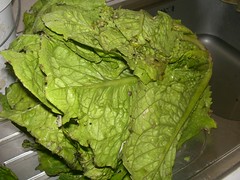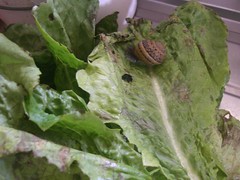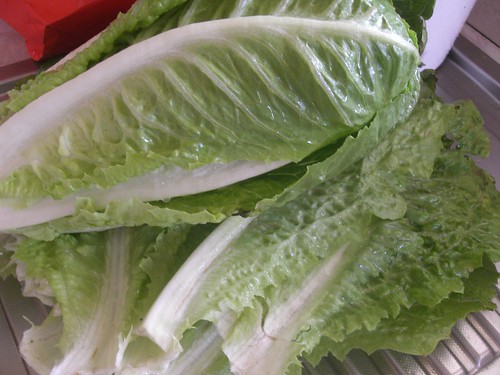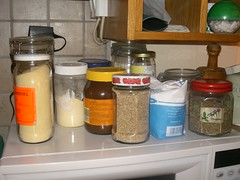The women's refuge worker claimed that refuges (like food banks) often have many tinned tomatoes in their pantries, often past their due date. Women who use refuges generally don't use tinned tomatoes, nor did the people who raised them, and some of the women who use refuges don't even (know how to) cook. So if you gave those women a choice, they would never even ask for tinned tomatoes. In other words: if a woman cooks with tinned tomatoes, its a cultural thing. Pasifika/Maori women - the main users of women's refuges in NZ - are unlikely to have a cultural background of cooking with tinned tomatoes. Middle class NZ society might be very surprised to discover this: some people just don't use this quintessential global pantry stocker. By judging these women on foreign (to them) cultural terms, ie as good and knowledgeable budgeters ("tinned tomatoes are cheap!", "tinned tomatoes are versatile!"), the 'tinned tomato brigade' can't actually see what these women are feeling when they enter a refuge, ie sadness, depression, shellshock, running away from violence. Coupled with a lack of life skills and literacy skills, being cash strapped, in debt and looking after children, they wouldn't even feel like cooking, let alone cook from scratch: tinned tomatoes usually imply cooking from scratch.
Women who turn to a refuge for help have no family support - if they did, they would not be asking a refuge to help them. The writer made a point of how important it was to help such women get what they wanted, rather than what other people feel they need. In such moments, they want simple comforts: "spaghetti on toast or really simple things, stuff [that can be eaten] straight from a can if needs be". Donors donate what they think poor people (which does not always mean the same thing as 'women in a refuge') need rather than want: "That’s you putting your values, and your mores, and your cultural prejudices on other people." Offering to teach women how to cook, how to use tinned tomatoes, and any other life skills they may be lacking is all very well, but there's a time and place for everything; when they arrive at a refuge, they need to settle into a new kind of life. Eventually, they may start preparing meals like they used to for themselves and their children; but some of these women may never want to cook, let alone from scratch. So tinned tomatoes are probably never going to be useful for them.

The writer made the analogy that "tinned tomatoes are a bit like books": just like we don't all cook, we don't all read. While cooking and reading may sound like very basic activities to some people, to others they are not. For some people, cooking and reading are very difficult activities. Giving things to people who need things is not the same as giving people presents: the things you give to people who need things have to be useful things. Giving tinned tomatoes - a very cheap common product - to someone who has never used them is like giving away your old books which you no longer wish to read to people who never read novels. The better off harbour comfortable perceptions about what others should be doing all the time to become better off.
The treastise against tinned tomatoes aroused a storm of comments from both sides of the argument. A (Maori) woman working for another women's refuge added canned chickpeas and canned lentils to the forbidden list of items that refuges didn't want:
"We ask for fresh meat and vegetables and we get beans and lentils. What are our people going to do with chickpeas? Are they going to be making hummus in the safe house? Like tinned tomatoes, chickpeas and lentils have to be cooked and accompanied with other ingredients, using knowledge and supplies that many families [don't] have."A (white) woman working for a Salvation Army food bank said she was shocked to hear that other charities were turning away tinned tomatoes:
"...the refuges are being a bit fussy... We are very short on things like [tinned] tomatoes... chickpeas and lentils are staples in Salvation Army food parcels given to families at this time of year... The staples are never going to go out of fashion. And hungry families will usually eat anything."Anything? I doubt it. (And she also put her cultural prejudices into the picture by calling women in refuges hungry.) Food is incredibly personal and highly cultural. Clearly the Salvation Army is catering for different kinds of people from those entering a women's refuge. People on a low income may also lead a more stable kind of life, not the nomadic existence of a woman fleeing from violence. Processed food is not necessarily the greatest miracle in the food world to make women's lives easier; having someone doing all the bloody cooking for you is even better than buying, carrying, storing, preparing and cooking food yourself. We don't all have that luxury of a private home cook; this usually happens when you are very wealthy or if you live in a cultural setting where one of the household's women (eg the grandmother) will prepare meals for all the family members, who may be working out of the home, or have been assigned other tasks. As mentioned above, if a woman has this kind of family support, she would not be asking a refuge to help keep her safe in the first place.

Snails and xinohondro - highly acquired Cretan tastes!
As I was following the discussion in the media, what really struck me was how unlikely it is among these refuges that someone will be cooking something for someone else, so that those people who need a decent meal (especially children) would find something that wasn't full of sugar/fat/salt (read: snack-type ready-to-eat highly-processed, eat-from-the-packet kind of food). It is already obvious that a lot of the people using these services don't have many life skills needed in order to maintain a healthy standard. So why not have someone cooking something on a regular basis, which can be served up to everyone and is also healthy and comforting? Some of the commentators mentioned that they would like to do such a thing as a cook-up, where some of the meals produced can be frozen for emergency moments. I think that the answer to this question will bring to the fore a host of other social issues that will be difficult to resolve.
It seems to have escaped people's notice that a lot of people in highly advanced countries like New Zealand are too busy to cook these days. This doesn't apply just to people in difficult situations. Most people in advanced countries spend their time in many creative ways, which often include doing things away from the home. And when they do have free time, they spend it more leisurely. Cooking is not a leisure activity when you are thinking about how to feed a family. It's a chore.


Cooking for others, cooking with tomatoes and cooking with beans are therefore all very culturally based. In truth, I cook tomato-based bean dishes not because they are the yummiest thing imaginable, but because I have to feed a family, and beans are a pretty good quick cheap choice of food which can be prepared the night before, by the working woman in the household. (I am doing this right now as I write: a pot of lentil stew is boiling away on the stove. It should be ready before midnight. No, I don't use a pressure cooker.) This is not to say that a woman living in New Zealand from the Maori/Pasifika cultures cannot do the same thing for her family as a Greek or Indian woman (two cultures which use beans a lot in their daily diet); she doesn't do this simply because it's not part of her culture. She could be taught to do something like this - but if it was never part of your culture to prepare food in this way, learning to do this kind of chore is very difficult in modern times, when people are generally being 'taught' to treat food as a commodity: you buy/eat food when it's time to eat, or when you're hungry, or maybe to comfort you - and it's all ready prepared by someone else, and - generally speaking - you will generally cook when you feel like it. What may have been part of the food culture of a Maori/Pasifika woman fifty years ago has now changed, due to her translocation - due both to internal and external migration - into a highly advanced society headed and directed by non-Maori/Pasifika leaders. No matter how settled a woman in New Zealand who has turned to a refuge becomes, she is unlikely to revert to a less processed-food daily diet.
The 'tinned toms' discussion that ensued tells us much more about comfort food, processed food, and the act of cooking, than it does about how to use tinned tomatoes. The following can be implied:
- Comfort food is ready-to-eat food
- Cooking is for people who lead stable lives
- Canned chickpeas and lentils are the kinds of food that connoisseurs, health-freaks, vegetarians, vegans (and generally other 'smart-farts') know about (and eat)
- Certain cultural groups eat a lot of chickpeas and lentils, so they will know what to do with them
- Certain classes of people - especially those whose lives are less complicated - have the chance to be more adventurous in their food experiences
- Canned food (eg chickpeas and lentils) is for poor people
- Canned tomatoes are useful in a home where the act (which is now often considered an art) of cooking can actually take place (read: you have a kitchen, a stove/oven, AND you can afford to pay the electricity/gas bills)
... inter alia.
Canned tomatoes - and muuuuuuuuch more recently canned beans, but never ever canned lentils, except at LIDL when it's having a 'Spanish week' - are highly popular among Greek food banks and especially in soup kitchens. They are cheap and easy to work with. They make quick filling meals. A heated tin of tomatoes could quite possibly be poured over some boiled pasta. BUT: If this was never part of your culinary repertoire, then you will not eat it, let alone know how to make it. Culinary knowledge in western countries has passed into the realms of mystery, while things like chickpeas and lentils are considered food for the poor - or food for cultured. Even Greeks will acknowledge that beans are cheap and that's why the eat them. Most Greek women with a family (including me) will cook up a bean dish once a week on a week-day, de rigeur.
I can't actually imagine any working Greek woman with a family here in Crete not cooking up a bean dish at least 2-3 times a month, but this is based on cultural norms. Greeks may have become impoverished - but still, there is much truth in saying that theirs is a dignified kind of poverty. We can have our cake and eat it, because we know how to make the cake. Greek identity these days often implies food knowledge. Recent Greek emigrants due to the economic crisis often end up working in their own food-based business. Their family background is not necessarily middle class. They rarely realise the superiority of their culinary skills because until they leave Greece, they do not realise that there are people out there who lack such knowledge. They are also astounded to learn that most people in highly advanced societies watch cooking shows and buy cookery books - but they rarely cook meals: most of their food will have been prepared by someone else, for them to heat and eat.
It's still not very common to see soaked ready-to-use chickpeas (let alone lentils) in Greek supermarkets; on the other hand, there is a plethora of dried beans on the shelves. If such canned products were presented to a Greek woman, and she was asked to produce something on the spot with them, I don't think she'd have much trouble producing a hot comforting meal in little time. All you need to make classic Greek φακές (lentil stew) and ρεβιθάδα (chickpea stew) are tomatoes, beans and water; if you add some minced onion and garlic, salt and pepper, your soup/stew - depending on the amount of water you add - will taste nicer. A hot bean soup made with canned tomatoes makes great comfort food - and it tastes better the next day.
Tinned tomatoes are often hailed as a food processing miracle by media cooks:
"The larder is worryingly bare when you've run out of tinned tomatoes. They are the cook's comfort blanket, the progenitor of any number of soups, sauces, stews and braises... Tomatoes are the best source of the carotenoid pigment lycopene. Some studies suggest it can help prevent prostate, lung, and stomach cancers. Tomatoes are an interesting exception to the rule that cooking food reduces or destroys valuable micronutrients: lycopene is better absorbed when it has been heated, either during processing or cooking, as the heat turns the molecule into more useful isomers. Tomatoes provide significant amounts of bone-strengthening vitamin K, and some research suggests that lycopene also supports bone health. Many studies link tomatoes with heart benefits, and although the mechanisms aren't yet clear, the antioxidant vitamins C and E in them, along with lycopene, seem to slow down the processes that would eventually cause heart disease."
In short, a pantry full of tinned tomatoes and chickpeas and lentils symbolises domestic wisdom, happiness and prosperity. But this is something that is not within the sight of a woman fleeing to a refuge with just her kids and the clothes they're all wearing. They'd rather be having some tea and toast, and maybe something sweet, like chocolate biscuits, to bump up their spirits. In other words, they want the same things you want. I highly doubt that the average citizen of a highly advanced society is eating tinned chickpeas or lentils cooked in tinned tomatoes on a daily, let alone weekly basis. We all want variety.
When buying "food for the poor", we really need to think about what we ourselves like to eat rather than what we think poor people 'should' be eating. Better still, charities can tell you what they need because they know who they're supplying. It's even better to give them money (they are likely to make better deals with suppliers), so they can do the appropriate shopping for that tiny segment of society that is rarely visible to the majority. Especially now before Christmas, to make it a merry one, skip that bloody canned food. As the Greek saying goes:
http://www.organicallycooked.com/2013/03/soup-kitchen.html
http://www.organicallycooked.com/2013/10/food-bank-community-grocery.html
http://www.organicallycooked.com/2016/04/the-social-kitchen-of-hania.html
All quotes come from the following links:
https://thespinoff.co.nz/parenting/11-12-2017/please-no-more-bloody-tinned-tomatoes/
https://www.radionz.co.nz/national/programmes/afternoons/audio/2018625266/jackie-clarke-no-more-tinned-tomatoes
https://www.stuff.co.nz/national/99767397/
https://thespinoff.co.nz/parenting/13-12-2017/no-charities-dont-want-your-inedible-food-items/
http://www.nzherald.co.nz/nz/news/article.cfm?c_id=1&objectid=11958543
http://www.newshub.co.nz/home/new-zealand/2017/12/charities-ask-kiwis-to-donate-more-than-second-hand-goods-or-tinned-vegetables.html
https://www.tvnz.co.nz/one-news/new-zealand/hamiltons-salvation-army-shocked-auckland-charity-turning-away-tinned-tomatoes
https://www.stuff.co.nz/national/99813458/we-want-tinned-tomatoes-hamiltons-salvation-army-says
https://www.stuff.co.nz/national/99909805/get-off-your-tinned-tomato-high-horse
https://www.stuff.co.nz/business/opinion-analysis/99946985/hype-about-tinned-tomatoes-has-raised-the-debate-on-giving
https://www.theguardian.com/lifeandstyle/2013/oct/05/tinned-tomatoes-health-benefits-anti-cancer-strong-bones


























